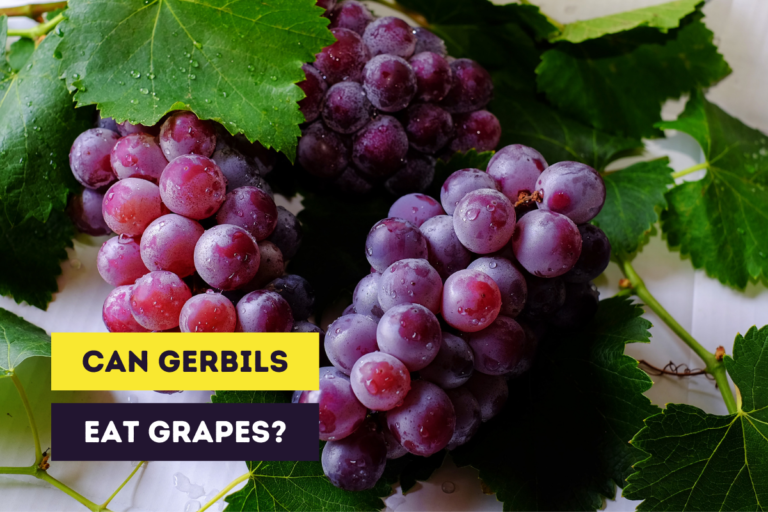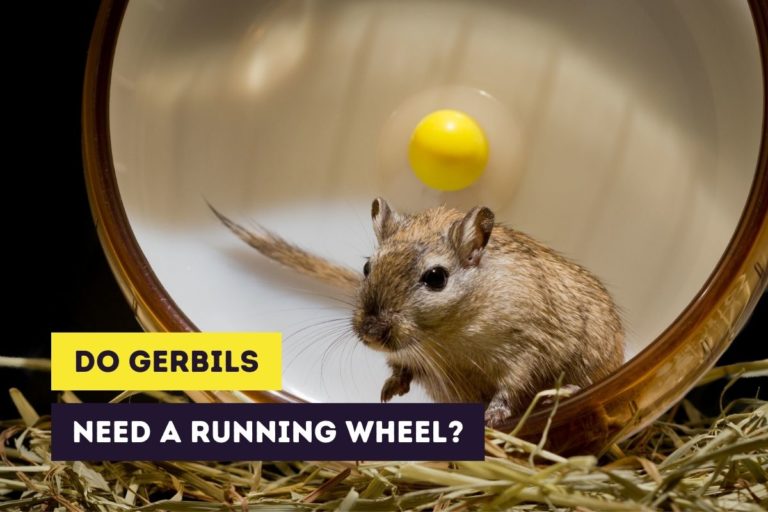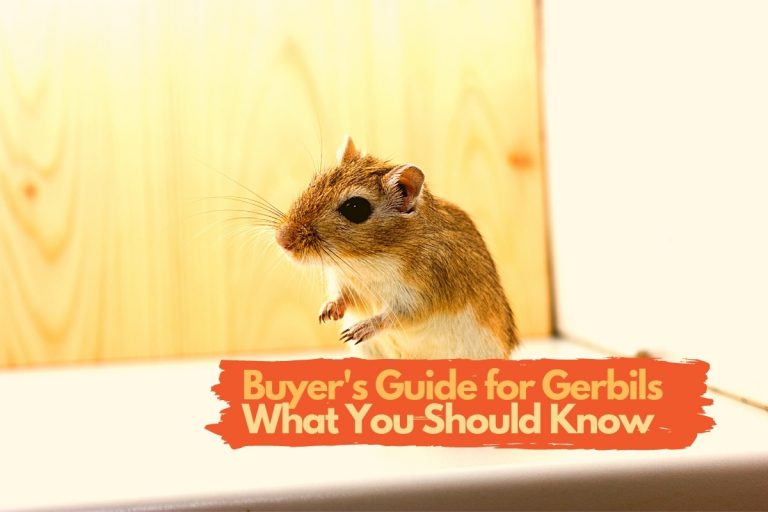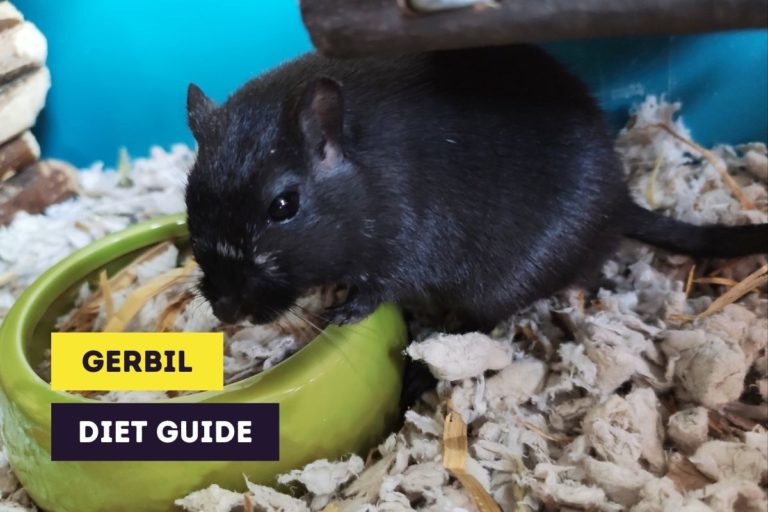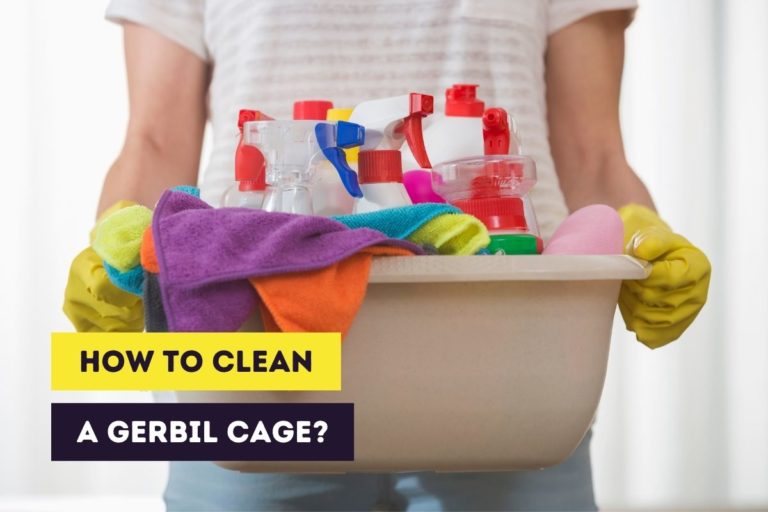Gerbil Cage Guide | Helpful Guide to Choosing Gerbil Cages
When you’re planning on getting a pair or small group of gerbils you’ll need to plan ahead and get an appropriate cage for them. Although a good and large enough cage is an essential product for pet gerbils it’s not easy to find cages that are suitable for gerbils.
A gerbil cage should be at least 20 gallons. The minimum cage size for a pair of gerbils should be 2,500 cm² (400 sq inches). The cage should have a height of at least 30 cm (12″). A gerbilarium (made of glass) is the recommended cage for keeping pet gerbils.
As you’ll notice gerbils need to be kept in a fairly large cage. Even larger cages are preferred, especially for small groups of gerbils, to mimic the natural habitat of gerbils. When you look for gerbil cages online or in pet stores you’ll have some difficulties finding an appropriate cage that ticks all the boxes.
In this article, you’ll learn about the requirements for the habitat of pet gerbils (including the minimum size), the cage location, and more importantly about the best gerbil cages out there.
This site contains affiliate links to products we recommend and use ourselves. We may receive a commission for purchases that you make through these links. If you’re interested in learning more about our affiliate links, please visit our (affiliate) disclaimer.
Natural Habitat of Gerbils
Most gerbils are social animals that live in small groups. Mongolian gerbils are no exception to this. They should in general always be kept in at least a pair although a small group can be better and more natural. For people that aren’t used to keeping gerbils as pets it’s advised to only get a pair of gerbils.
In the wild, gerbils will form groups between 2 and 20 animals and their territory is (compared to their small size) very big. A study published in the journal Animal Behaviour has showed that the size of the territory of gerbils is between 325 and 1,550 square meters. The size of the territory depends on the size of the family and also seems to depend on the size of the alpha male, which is the leader of the group and is the largest male gerbil in the group.
In the territory gerbils will create a burrow with (mostly) interconnected tunnels. Gerbils will often build their burrows near plants so they can use the plant roots for additional support to their burrows. A burrow will have different chambers for nesting and storage. There can also be a toilet chamber.
Gerbil Burrows
An interesting study concerns the “glass gerbil city”. In this study a glass enclosure was created in the shape of a square-cornered horseshoe. The enclosure had a metal floor and was open at the top. Contrary to most captive (laboratory) gerbils they were housed in a very large enclosure with an height of 122 centimeters and a width en length of around 3 meters (exact measurements can be found in the mentioned study). The enclosure was filled with a sandy loam to a depth of 60 centimeters.
The following interesting points can be taken from this study:
- tunnel levels: there were two levels of tunnels, one near the surface and one along the floor.
- entrances and exits: 20 entrances or exits were found and these were near the base of a rock, log, or against the glass side. All tunnels were withing 150 centimeter of an entrance.
- interconnected tunnels: all tunnels were interconnected with each other, with the exception of a partially collapsed and abandoned tunnel.
- tunnel length: the average tunnel length was 40 centimeter and the longest was 130 centimeter.
- chambers: there were two nest areas, a food storage area between the nests, two toilet areas, and two larger (den) areas whose function wasn’t determined.
You can see that gerbils will create extensive tunnels when given the opportunity. For this reason, it’s best to get a cage for your gerbils that’s large enough and that provides deep enough bedding to create tunnels.
Gerbil Cage (Size & Material)
Gerbils are animals that are used to large territories. The smallest territory size in the wild would be 325 square meters for only a small number of gerbils. The average house size differs from country to country. In the United States, the average house size is around 2,000 square feet. Translated to square meters this is 185. So you’ll have a hard time recreating an entire ecosystem for gerbils in an average-sized home or apartment.
Luckily, gerbils can also be happy if they’re kept in a smaller habitat. Gerbils are being kept as pets in smaller cages for many years. But you do have to be aware that a gerbil cage needs to be suitable for them. This means that it:
- should be as large as possible (minimum size requirements)
- is made from the right material (cage material)
Minimum size of a gerbil cage
There’s a lot of discussion about the right size for a gerbil cage. The minimum cage size depends on the number of gerbils you keep and gerbils will be happiest in large cages.
To determine the minimum size for gerbil cages I’m going to give you more information about the recommended (minimum) cage size. To start I want to give you a head start. There are a lot of anectodical sources that set a minimum of 10 gallon for a pair of gerbils (so 5 gallon per gerbil). But is a 10 gallon tank really large enough?
Gerbil societies and groups
There are a lot of local and national groups and societies that have formed around the pet gerbil. The most well-known groups that also have an online presence are:
The American Gerbil Society recommends a minimum size of 5 gallons per gerbil (so 10 gallons for a pair) although 15 or 20 gallons is more preferable. The National Gerbil Society recommends a simple glass or plastic aquarium of 38 cm x 30.5 cm x 25.5 cm (15″ x 12″ x 10″) for a pair of gerbils (source). This is about 7.8 US gallons.
Merck Vet Manual
The Merck Vet Manual is a trusted source for veterinary information and has information about all kinds of animals and pets. They recommend that each gerbil gets 5 gallons of space. So a pair of gerbils require (at least) a 10-gallon cage.
Animal welfare organisations
The American Society for the Prevention of Cruelty to Animals recommends that you keep gerbils in the biggest cage you can afford with a minimum of 10 gallons for 2 gerbils. The same advice is given by the Animal Humane Society. PETA doesn’t give a specific minimum cage size for gerbils but does recommend a 2 ft square cage (60 cm) for hamsters.
National regulations
In some regions, there are strict policies on the minimum size of cages for gerbils and other animals. These regulations are mostly for sellers of pets and for laboratory animals:
- Animal Welfare Regulations (England): the minimum area for 1 to 4 gerbils is 680 cm² with a minimum cage height of 30 cm and a minimum cage depth of 25 cm. There are also higher standards that set a minimum area of 1,250 cm² (up to 4 gerbils).
- Swiss Animal Protection: this regulation sets a surface minimum area of 0.5 m² for two to 4 gerbils. Each additional gerbil adds another 0.05 cm² of surface area.
- European Convention for Protection of Vertebrate Animals: this convention sets a minimum enclosure size of 1,200 cm². The floor area per gerbil should be 150 cm² per animal (weighing up to 40 g) and 250 cm² per gerbil (for gerbils over 40 g). The minimum cage height should be 18 cm.
Conclusion
As you can see, there are a lot of different views on the minimum size requirements for gerbil cages. The main consensus seems to be that a 20-gallon cage for a pair of gerbils is most suitable.
There’s a fear that larger groups of gerbils that are being kept in too large cages will declan and form separate groups that fight over territory. However, this isn’t properly researched and more study is needed. In the wild, gerbils will have much larger territories and declanning can happen for a variety of reasons other than a cage that’s too large.
My recommendation would be to get a cage that has at least a height of 30 cm (12″). This accounts for a thick layer of bedding and enough space for your gerbil to stand upright if it wants to. The surface area should be at least 2,500 cm² (400 sq inch) for a pair or trio of gerbils. This forms a cage with a volume of 20 gallons.
Larger cages are even better, especially when you plan on keeping more than two gerbils or intend on breeding gerbils. These are just minimum cage sizes for a pair of gerbils.
Types of gerbil cages
Small pets, like rodents, are usually kept in wire cages that are made from metal and plastic. A less common enclosure for such pets is a vivarium, which is a glass tank. There are different names for a vivarium depending on the animal that is housed within aquarium (for fish) or terrarium (for reptiles. The term vivarium is the generic term for these enclosures.
I’l get into the most suitable cage type based on the following factors:
- cage material
- ventilation
- ease of cleaning
- suitability for burrowing
These factors will be discussed for 3 different kinds of cage types:
- wire or mesh cage
- tank with a cage topper
- vivarium
Wire or mesh cage
A wire or mesh cage has a plastic or metal base that allows for a thin layer of bedding and has a wire mesh top with vertical or horizontal bars. Sometimes the top is made of plastic with only a ventilation grid that has metal bars.
Let’s find out if these kind of cages are suitable for gerbils:
- cage material: the cage consists of a plastic base that can be chewed on by your gerbils. The metal bars are chew-proof.
- ventilation: the bars in a typical wire cage have several mm of space between them. This allows for enough ventilation but can also pose a hazard to drafts.
- ease of cleaning: wire cages are very easy to clean. The cage top and the plastic base can be easily separated and you only really need to clean the plastic base thoroughly.
- suitability for burrowing: most wire cages have only a plastic base that is less than 15 cm (6″) deep. This makes them unsuitable for burrowing. Besides that, while burrowing, there can get substrate and bedding kicked from the cage through the bars.
So, wire or mesh cages are good cages when it comes to the cage material, ventilation, and ease of cleaning. The only real problem that most wire cages have is that the plastic base isn’t deep enough and that bedding can get kicked out of the cage.
However, if the size of the cage is large enough and if there’s enough space for burrowing you can use a wire cage as a gerbil cage (see recommended cages below).
Tank with cage topper
A popular choice for burrowing pets is an old tank with a cage topper on it. You can also buy this combination in stores and online. This kind of cage consists of a deep tank part that can be made of glass or plastic. The cage topper is usually made of metal bars and looks similar to the top of a wire cage.
Let’s find out if these kind of cages are suitable for gerbils:
- cage material: the cage consists of a glass or plastic base. If the base (tank) is made of glass there is no problem of chewing. Both the glass and metal bars of the cage topper are chew-proof. However, if the base is made of plastic it can be chewed on.
- ventilation: the bars of the cage topper have several mm of space between them. This allows for enough ventilation but can also pose a hazard to drafts.
- ease of cleaning: this kind of cage is very easy to clean. The cage topper and the tank can be easily separated and you only really need to clean the plastic or glass tank thoroughly.
- suitability for burrowing: the tank is usually deep enough to allow for burrowing. There can still get substrate and bedding kicked from the cage through the bars but it will be more difficult and a lot less.
Tanks with cage toppers are good cages when it comes to the cage material, ventilation, ease of cleaning, and suitability for burrowing. However, it’s still possible that bedding gets kicked through the bars.
If the size of the tank and cage tapper is large enough and if there’s enough space for burrowing you can use a tank with cage topper as a gerbil cage (see recommended cages below).
Vivarium
A vivarium is made from glass with a frame that can be made from different material (even wood). When talking about gerbils, a vivarium is also called a gerbilarium.
Let’s find out if a gerbilarium is suitable for gerbils:
- cage material: the cage consists of a glass and a frame. There is little to no risk that your gerbils can chew through the frame or top.
- ventilation: a gerbilarium usually has ventilation through the screen top on it. Sometimes there are also small ventilation holes on the sides which can form a risk when your gerbils can chew on it and make the hole bigger.
- ease of cleaning: this kind of cage is not always as easy to clean. The gerbilarium can be heavy and difficult to move. You’ll also need to get deep in the gerbilarium to remove all bedding and clean the gerbilarium.
- suitability for burrowing: a gerbilarium is usually the most suitable for burrowing pets like gerbils. It has a lot of depth to add a thick layer of bedding.
A gerbilarium is – in my opinion – the most suitable cage for gerbils. It provides enough space for burrowing and limits the risk of a gerbil escaping. If you have enough space and budget, choose a gerbilarium as a gerbil cage (see recommended cages below).
Cage Location
It’s important to place the cage or gerbilarium in a location where it is safe for your gerbils and where you can still enjoy them. There are several things you need to take into consideration when it comes to cage location:
- exposure to direct sunlight
- natural day- and night light cycle
- temperature in the room
- accessibility to other pets
- placement of the cage itself
Importance of light for cage location
Gerbils are crepuscular pets that are both active during the day and night, with a tendency to be more active at twilight (dusk and dawn). Your gerbils will use the light in the room they’re in to guide their sleeping habits.
It’s best to keep your gerbil cage in a room where there is a natural day- and night light cycle. Keep it, for example, in a living room where indirect sunlight lightens the room during the day.
However, you should never put the cage in direct sunlight. When direct sunlight hits the cage it can heat up the cage very fast (especially with a real gerbilarium) which can cause serious health issues.
Importance of temperature on cage location
Gerbils live in an arid region where temperatures can get really high. At these times they’re less active and will stay in their cooler burrow. If they would stay outside and wouldn’t have a chance to cool down they would get a heat stroke.
The natural habitat of gerbils can also get really cold and gerbils will use their fur and social nature to keep warm in their burrows. Gerbils can survive colder temperatures, especially when they’re kept indoors where the temperature isn’t extremely cold for extensive periods.
Gerbils do have an ideal temperature range (20°C to 24° C / 68°F to 75°F) which is roughly the same as normal room temperature. In most circumstances, you won’t have to do anything about the temperatures. Just don’t place them in naturally cold rooms like a basement unless you can provide an ideal temperature (and a natural light cycle).
However, if temperatures get too high you’ll need to cool the cage down. You can do so by relocating the cage to a cooler room or by using an air-conditioning in the room. When you use an air-conditioner or a ventilator, make sure that the cage isn’t located near them as it can cause health problems.
If temperatures get too low, you’ll have to make sure that your gerbils stay warm. You can do so by giving them enough nesting material to line up their nests. Another way to heat up the room is by using a heater or heating system. Don’t place the cage near the heat source as this can cause serious overheating.
Importance of the placement of the cage
When you’ve chosen the room for your gerbil you’ve also got to consider how you place the cage. You should place the cage:
- on waist level or higher: gerbils are prey animals and are preyed upon by birds of prey and snakes. Their natural instinct is to run when they encounter a predator or bite in extreme cases. To prevent scaring your gerbils it’s best to approach them from the same level. Make sure that you don’t have to reach from above and that your gerbils can come to you at waist level (or a little bit higher).
- away from (predatory) pets: cats and dogs are popular pets but can pose a danger to your gerbils. Especially cats can be dangerous and can claw at your gerbils when they’re in a wire cage. Even if your cat can’t reach your gerbils it can stress your gerbils to have a cat or dog in their vicinity (for example a cat lurking near the cage). Never leave your cat or dog alone in the room of the gerbil cage and definitely don’t handle them in their vicinity.
- away from heat and cold sources: as I already mentioned you should keep the gerbil cage at a large enough distance from natural (direct sunlight) or artificial heat sources (heaters) but also from cold sources (like a ventilation system).
Examples of unsuitable cage locations
There are some locations that are more suitable than others to place your gerbil cage. Here are some “bad” cage locations, although a lot will depend on the particular situation in your home:
- bedroom: gerbils are active throughout the day and when you place a cage in your bedroom it’s possible that they will make noises that wake you up. Besides that, it’s never a good idea to place a cage in a bedroom because it can lead to the development of allergies.
- garage or shed: garages and sheds are usually colder than the rest of the house. Also, exhaust fumes from cars or motors are dangerous for your gerbils.
- kitchen: this location isn’t suitable because it is unhygienic to keep gerbils in a room where food is prepared or consumed.
The above locations are also less suitable because you’ll not see your gerbils as much as when you house them in your living room. This can cause issues if you’ve got a cat or dog. In such a case it’s perhaps better to keep them in another room where you still can have enough contact with them.
Tips and Tricks for Choosing a Good Gerbil Cage
Now you know what the requirements are for a good cage. But I’ve got a few more tips and tricks for you.
- bar spacing: gerbils are small rodents and can squirm themselves through small openings. If you get a wire cage, you should make sure that the space between the bars is not larger than 1.3 cm (0.5 in).
- cage floor: opt for a solid floor made of metal and not a floor made of wire mesh. If the floor is made of wire mesh, your gerbils will get injured when running on the floor. You can use bedding on the wire mesh, create a solid platform, or use a kind of cage mat made of soft material.
- secure the cage doors: gerbils are intelligent and fast creatures. They can escape when the cage door isn’t secured. Also, young children can be tempted to open the door and handle your gerbils. Handling by young children should always happen under supervision. So, it’s best to use a lock to secure the cage doors.
- double doors: a cage with double doors makes life a lot easier. It’s a lot easier to feed your gerbils and to clean the cage.
Recommended Gerbil Cages
Most cages that are being sold for gerbils are also sold for hamsters or other kinds of rodents. Almost all cages have no or only limited space for a thick layer of substrate (bedding).
Gerbils are animals that live near the surface and in their burrows. They don’t really need a lot of climbing space (or a vertical cage). However, to create enough flooring space often multiple levels are created in gerbil cages (similar to degu cages).
In my opinion, the best cage for gerbils is a gerbilarium but a more common and good option is a tank with a cage topper of it. Unfortunately, there currently aren’t a lot of good gerbil cages on the market (especially outside Europe).
To help you find the best gerbil cage for your own situation, here’s my list of recommended cages. For this list, I chose cages that:
- has at least 30 cm (12″) of height: this will provide enough room for a thick layer of bedding and allows the gerbils to still stand up.
- provides at least 2,500 cm² (400 sq inch) floor space: this allows for enough running space for at least a pair of gerbils.
This does mean that the cages have a minimum volume of 20 US gallons. If you want to calculate the volume of the cages below or from a self-made-tank I would recommend this tank size calculator.
| Name | L (in) | W (in) | H (in) |
|---|---|---|---|
| Savic Habitat Cages for Gerbils | 27.5 | 14.5 | 20.5 |
| Skyline Small Pet Terrarium Marrakesh | 37.8 | 18.5 | 15 |
| Aqueon aquarium | 30.25 | 12.5 | 12.75 |
| Repti Zoo Reptile Glass Terrarium | 36 | 18 | 24 |
| Carolina Custom Cages Bio Deep | 24 | 18 | 30 |
| Living World Green Eco Habitat | 39 | 24.5 | 23 |
Savic Habitat Cages for Gerbils and Hamsters
The Savic Habitat Cages for Gerbils and Hamsters is a horizontal cage that consists of a plastic tank and a cage topper. It’s 70 cm x 37 cm x 51 cm which isn’t large enough for more than a pair of gerbils. It’s the bare minimum for a pair of gerbils and I would recommend that you only keep a pair of young gerbils in them.
Alternative option: You can also adjust a 10 gallon (old or new) aquarium with a cage topper like the one from Ware Manufacturing. This will mimic the Savic cage and can be cheaper.
Skyline Small Pet Terrarium Marrakesh
In Europe, there are a few online stores that sell larger gerbil cages that are more suitable for burrowing creatures like gerbils. If you live in Europe I would recommend the Skyline Small Pet Terrarium Marrakesh. It’s a horizontal wood and glass tank that is both large and deep. It also comes with a wire mesh top to allow ventilation.
Aqueon aquarium (20-gallon or larger)
In most cases, gerbil owners end up buying an aquarium and custom fit it for their gerbils. A 20-gallon aquarium like the Aqueon aquarium is good for a pair of gerbils. You can also get larger aquariums up to 75 gallons. There is sometimes concern that too large tanks will lead to fights between gerbils but this is debatable. You can create a top for the aquarium with wire mesh or you can buy a screen cover for it.
Repti Zoo Reptile Glass Terrarium
The downside of an aquarium is that it’s often made of heavier glass and that it is difficult to move. Another good option is a terrarium for reptiles. These usually weigh less and have a screen top on them already. The Repti Zoo Reptile Glass Terrarium comes for example in a size of 90 cm x 45 cm x 60 cm (36″x18″x24″). There’s also a version RK0119N that is 45 cm (18″) in height. However, this version only allows for a layer of 9 cm (3.5″) up to the double doors while the RK0120N has a place for a layer of 18 cm (7″).
Be aware that the double doors can’t really be opened if there’s a thick layer of bedding in it. The larger version does allow for a fairly deep layer that isn’t achievable in most other cages that are being sold. Another concern is that your gerbils might be chewing on the lock of the double doors.
Carolina Custom Cage Bio Deep
If you’re looking for a terrarium with enough space to create a 30 cm (12″) layer of bedding I would recommend a terrarium from Carolina Custom Cages. The Bio Deep cage has 12″ between the bottom and the start of the double doors. The terrarium is originally for reptiles but can also be used for burrowing pets such as gerbils.
Living World Green Eco Habitat
Similar to the Skyline terrarium the Living World Green Eco Habitat can be used as a gerbilarium. It is very large and provides a lot of space to put in a deep layer of substrate (bedding). It’s also a fairly cheap option compared to the usual terrarium for reptiles.
Want to Learn More?
If you’re interested in learning more about gerbils as pets (or other pocket pets), please read the following articles:
If you’re interested in getting gerbils as pets you should also definitely read our beginner’s guide to keeping gerbils as pets and our gerbil care guide.


